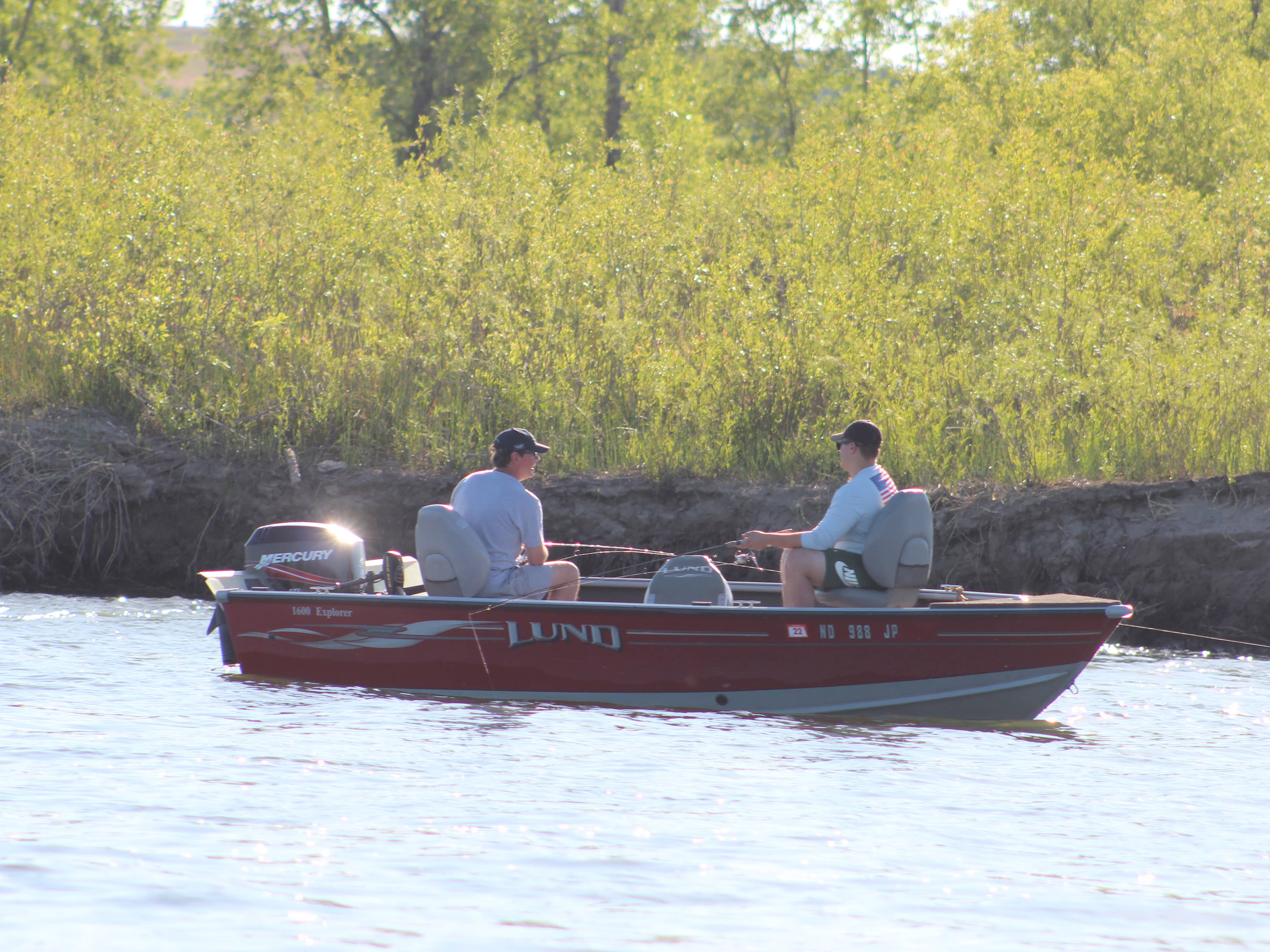
Anglers target a deep channel cutting along the shoreline in the shade to find summer walleyes on the Missouri River. Simonson Photo.
By Nick Simonson
The continued drought and dry conditions have lowered flows from western North Dakota to eastern Minnesota during this long, hot summer.
Since early spring, I’ve walked the shores of a number of rivers and streams and driven over hundreds of others in my travels and their conditions have at times made my jaw drop. I can never remember seeing no water flowing into the Sheyenne River from the Baldhill Dam, but that was exactly the case as I visited my home flow in April.
It was a portent of things to come, as water levels around the region have fallen precipitously with the lack of rain. Photos of Gooseberry Falls completely dry on Lake Superior’s north shore, and stories of the Mississippi River being wadeable many miles downstream from its source have followed and receding shorelines throughout North Dakota and Minnesota have circulated this summer on social media and through traditional outlets.
However, these rivers and streams still support fish for those willing to find them, and the challenges of low waters can provide greater insight into angling for fish in difficult conditions and provide clues for future efforts when rains and increased flows return.
Slow & Clear
Remaining pools and deeper runs are where summer fish will locate in low flows. Identifying those spaces is the first key in finding riverine success for all species in summer. Walleyes will likely locate where they can find protection from the sun at midday in the deepest possible portion of a river. Add in some structure like boulders or tree stumps, and the deep spot becomes a primary stop on any low-water fishing adventure. In the low water, which is often clearer due to the lack of runoff and sediment, lighter lines and fluorocarbon leaders will help convert these fish, and live bait should be a consideration.
In these warmer waters too, identifying cooler stretches will likely provide a suggestion as to where fish are locating. Continuous shoreline seeps and springs that are not subject to surface waters, but are fueled by underground flows and aquifers, pump cold water into a system to the benefit of summertime fish seeking relief from the warmth. It’s not unusual to find groups of bass, pike and even muskies laying in the line of inflowing cold water, trying to beat the heat. Spring-fed creeks that join rivers will also provide similar respite and checking the junction of a main flow and its tributary can pay off with fishing as hot as the weather.
Probe the depths adjacent to these inflows on lower-than-normal rivers to find fish until levels rise again or things cool down with autumn’s approach.
At Your Own Risk
Navigating low waters is perhaps the biggest challenge this summer for those looking to continue angling despite the conditions. Historic lows on the Red River of the North and many other streams have made boat use challenging. Exposed shorelines of mud and sediment on other rivers make accessing the water’s edge difficult and more than a few times have likely claimed wading shoes or hip boots when anglers get stuck. Exercising caution while boating or wading are important for angler safety during this time of decreased water.
Keep an eye out for obstructions which would normally be several feet lower in the water column, such as large boulders or deadheads, capable of damaging a boat’s hull or motor. Watch for changes in current or boils in the flow ahead to serve as clues of those objects and others below the surface which may pose a threat to navigation. When heading under bridges, utilize the center opening where possible to find the deepest water for travel and avoid the pilings where debris has stacked up. As always, wear a life jacket while boating, even if the water is warm.
Don’t Lose The Lesson
While the loss of water in many rivers this summer may be astounding and even disheartening, there are many lessons to be learned and filed away for future reference and better fishing. Whether walking the shoreline or boating along, even if the angling isn’t all that successful in favorite go-to spots, low waters often give up a river’s secrets about why certain places are so good when conditions are at their best and provide hints as to other spots which may have been previously overlooked.
Looking for those points of rock which are normally submerged, identifying boulders out of the water which once provided breaks in the current, and picking out transition areas of scoured gravel amidst a mud flat give pointers to potentially unknown fishing spots when waters rise once again. Make notes of them in a fishing journal or drop a pin on a GPS to come back and visit those areas when conditions improve. It’s likely walleyes, bass and other fish will relate to them then as well.
River fishing doesn’t have to end when waters drop in summer, be it a dry season like this one or what’s normally expected. Take these tips and precautionary measures to heart and find fast action even when the situation appears challenging.
More importantly, take what you learn about your favorite flows when the substrate can be seen and save it for next season, when hopefully, more water will be moving through.
